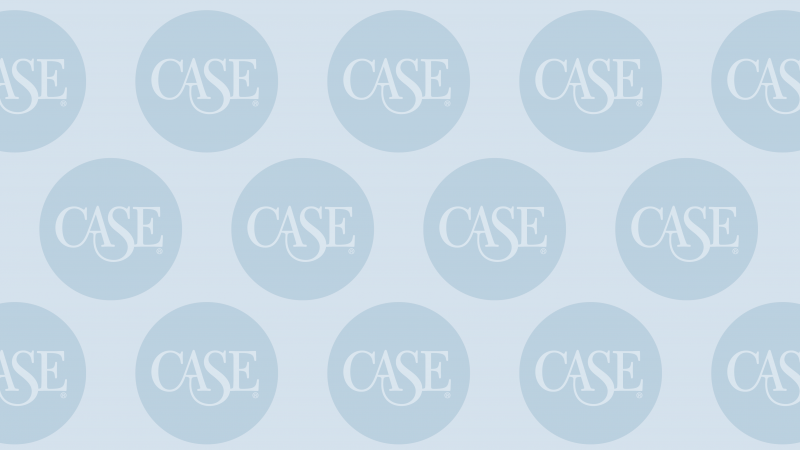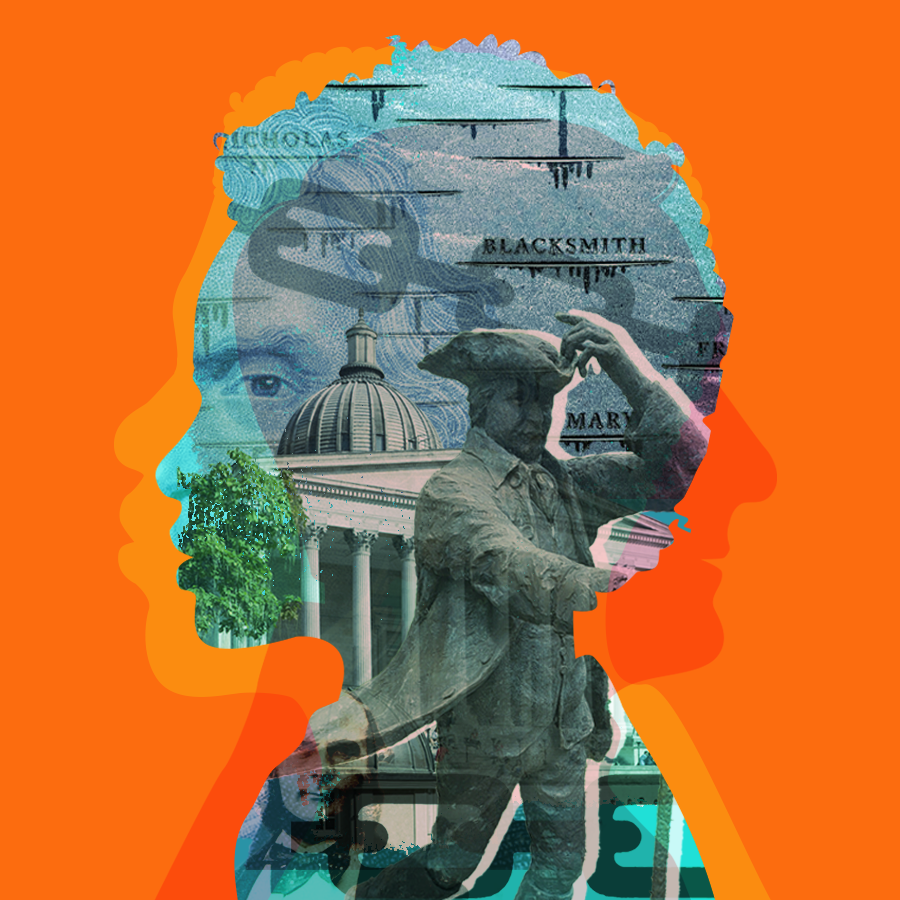
Reckoning with the Past
Heleena De Oliveira experienced little racism growing up as a Black woman among the predominantly Black population of Nairobi, Kenya. She didn’t encounter such prejudice until she left for boarding school in England.
One of her sharpest memories from that time involved a white classmate haranguing her in class because societal mores barred him from using the N-word. She remembers how the teacher and class watched and did nothing.
For college, De Oliveira knew that McGill University in Montreal, Canada, was academically challenging. Friends told her the city and campus were vibrant. She moved to Canada in 2018 to begin studies toward law school.
De Oliveira spent her first year at McGill seeing few people who looked like her, but discovered the Black Students’ Network of McGill and began meeting other Black and brown members of the campus community. She grew so involved with the BSN that she became its president in 2020.
But De Oliveira got a shock when she encountered a fellow BSN member while walking past the campus statue of James McGill, a Scottish-Canadian businessman and philanthropist whose bequest of land and money led to McGill University’s 1821 founding.
The BSN member “casually told me, ‘Oh, did you know James McGill owned slaves?’” De Oliveira recalls. “It was a very casual, weird experience, just to be told in a nonchalant way that the founder of our university owned slaves.”
From there, De Oliveira went down a “rabbit hole” of learning, finding evidence that James McGill mistreated enslaved Black and Indigenous people as unfeeling property.
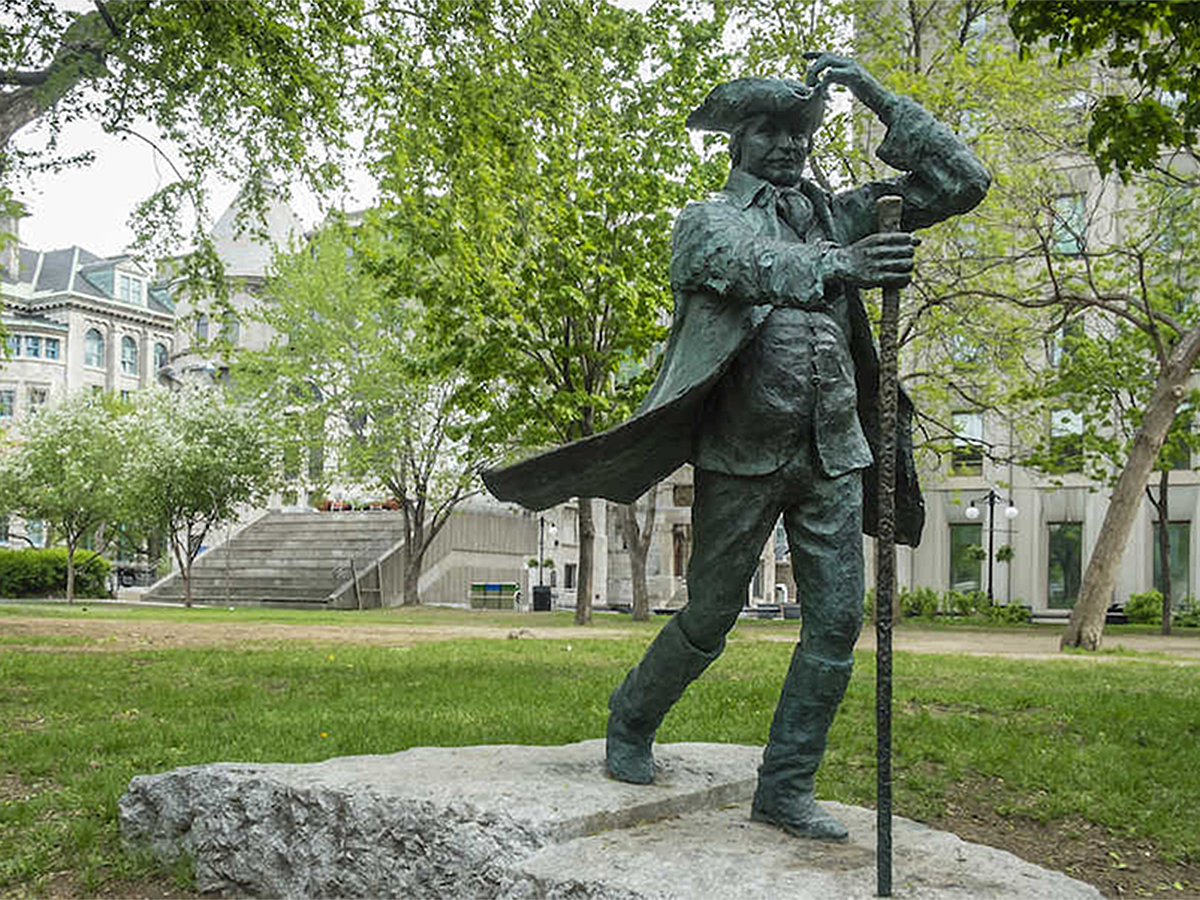
JAMES McGILL: This statue of James McGill, namesake of McGill University, is the focus of much reflection and debate at the university. McGill was a slaveholder.
For those reasons, De Oliveira, the BSN, and student and alumni activists are calling for the removal of the McGill statue, erected in 1996 to celebrate the university’s 175th anniversary. One alumna is circulating a Change.org petition, asking for the statue to be replaced by a tree. Yet others on and off campus say that interfering with the statue amounts to uprooting the institution’s foundation.
The statue “feels so blatantly rude and disrespectful to me,” De Oliveira says. “It’s the first thing you see when you walk in. Most people at the university don’t even know what it symbolizes.”
De Oliveira and Christopher Manfredi, McGill’s provost and vice principal (academic), agree on this lack of awareness. Manfredi acknowledges that the university has not been as forthright about the totality of James McGill’s past as it should have been.
“It’s a fair criticism to say the university’s portrayal of James McGill has been tilted toward the positive aspects of his life,” he says. “I don’t think we’ve tried to hide it, but McGill has not put as much emphasis on the fact that he owned enslaved persons. I think we’ve brought those aspects to the forefront now.”
Manfredi says that the institution will place a plaque near the statue in spring 2021 to bring context to James McGill’s history as a trader and owner of enslaved people. Meanwhile, McGill will consider removing or retaining the statue as part of its five-year Action Plan to Address Anti-Black Racism, with a final decision due in the next 12 to 18 months. On this and other issues, Manfredi says the university is committed to listening to all of its constituents’ perspectives—a difficult, long, and necessary process.
McGill University is just one of multiple institutions around the globe where similar painful debates about the most visible symbols of racism and discrimination are playing out. Campus communities—students, educators, alumni, administrators, community residents, donors, and others—are confronting history, with many pushing institutions to act decisively.
A Necessary Conversation
One aspect of this reconciliation is the presence of monuments, statues, and building names glorifying philanthropists, scholars, and historical figures who were participants in the slave trade, leaders of discrimination, or supporters of eugenics (the concept of selective breeding to weed out so-called undesirable races, ethnic groups, and people with disabilities).
Education—like other pillars of society—is undergoing self-reflection, and prominent public art and buildings are obvious targets. But it can be awkward for some stakeholders. Beyond discomfort, reconciling past with present is an exercise imbued with heightened emotions and conflicting perspectives that can make for a crooked road toward resolution.
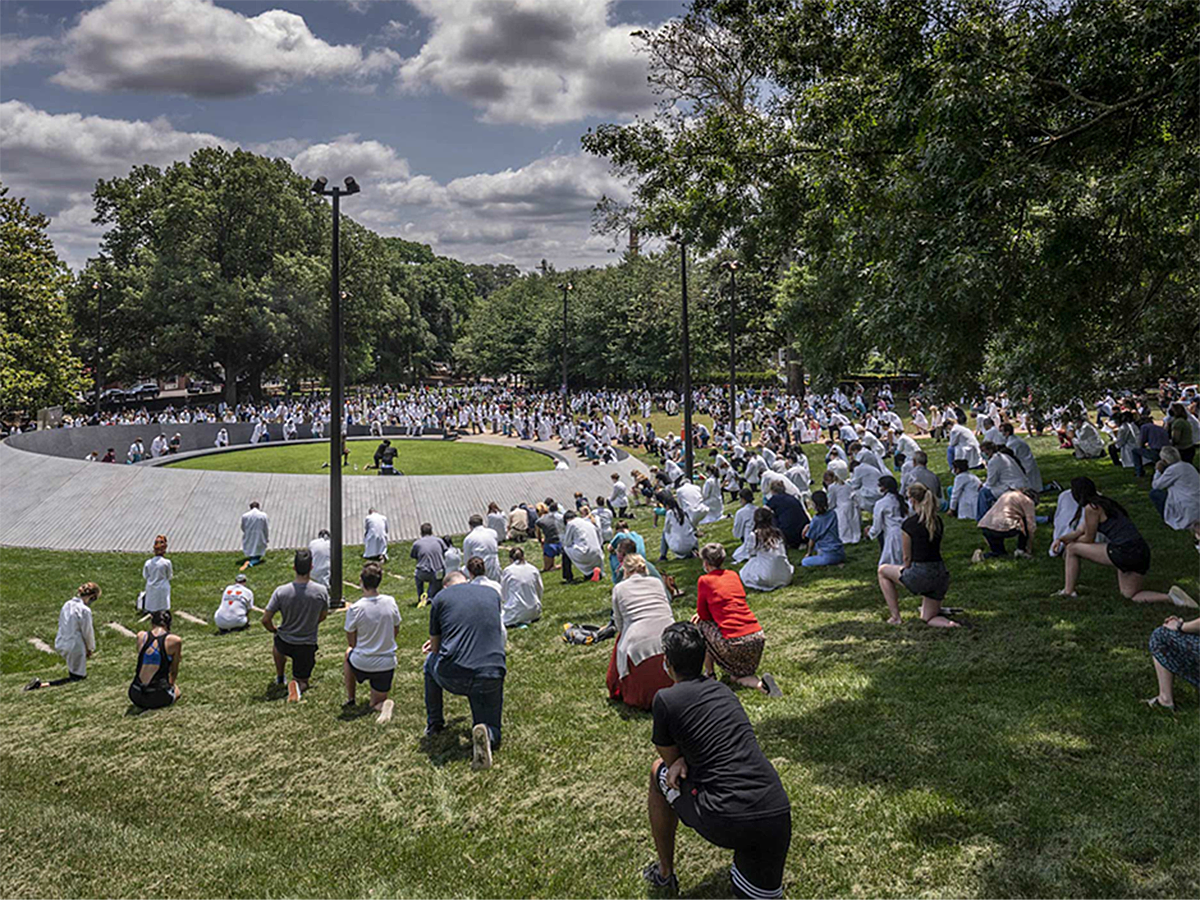
On June 5, a crowd, including many UVA Health employees, gathered to honor George Floyd and support the “White Coats for Black Lives” movement to raise awareness of police brutality, inequality, and racism in health care, and demonstrating solidarity with the Black Lives Matter movement.
Leaders who are seeking to square their institution’s past, present, and future emphasize that it is crucial for all parties to be heard and all sides represented in the conversations. Manfredi says it’s a lesson that educational institutions learn repeatedly.
“As we did consultations, I got a much more personal understanding of the challenges our Black constituents face,” Manfredi says. “It’s not an experience I’ve ever lived, so it’s important for me to hear those stories.”
Steven Clark, vice president of university relations and marketing at Oregon State University in Corvallis, U.S., stresses the need for listening, then doing “what a university should do well” by applying that learning to research.
“It is extraordinarily important to listen both with attentiveness and empathy, both for those that would support name changing and as well as those who might not,” Clark says. “It is not acceptable to say, ‘We know better because we are a university.’”
Oregon State underwent a renaming overhaul in 2016–17, embarking on significant research and community conversations to understand the history behind the names of buildings on campus. Clark—who chairs the Architectural Renaming Committee—says he was heartened by the support of alumni to investigate Oregon State’s legacy.
After a two-year review, the university opted to change the names of Avery Lodge (named for Joseph Avery, who owned a pro-slavery newspaper) and Benton Hall and Benton Annex (whose names reference Thomas Hart Benton, a white supremacist who advocated transferring Native American land to white people).
In that same review, Oregon State opted to retain the name of Gill Coliseum after research showed that its namesake, late basketball coach Amory “Slats” Gill, did not prevent integration of the basketball team, as had been suspected. He actually tried—unsuccessfully—to recruit Black athletes.
Clark says the overhaul was eye-opening in terms of the number of alumni and donors who were open-minded about the committee’s research and final decisions.
“Some of the folks who were the most concerned in the case of Gill Coliseum—former student-athletes, some of whom have remained involved as affluent alumni or donors—we saw they were among the most supportive of an evaluation,” he explains. “The grandson of Slats Gill said, ‘You are doing what you should do.’ He came to a meeting, as did his mother.”
Those name changes have led to more forward motion on campus, Clark says. The debates highlighted the fact that the university must do more to recruit and retain Black students.
Oregon State isn’t alone. Educational institutions worldwide are under pressure to evolve amid increasing migration and larger Black and brown populations. The U.S. Census projects that whites will become a minority population by 2045—a distinction that’s coming sooner for younger demographics due to increasing Latinx, Asian, and Black populations. According to the Canadian Census, the country’s visible minority population (an amalgam of residents who are Black, Asian, Latinx, and other nonwhite ethnicities) increased from 11.2% to 22.3% in recent decades and will continue on that path. Pew Research Center data suggest that Africa will be the only region to see a significant population boom this century, while Europe’s population will begin declining by the year 2100.
Meanwhile, the voices of underrepresented students are becoming more insistent in the wake of widespread protests that followed the May 25, 2020, murder of George Floyd, a Black man, under the knee of a Minneapolis police officer.
“When they’re telling the university, ‘We feel like we are actively harmed by living in a landscape that unequivocally celebrates white supremacists, segregationists, and enslavers,’ it starts a conversation,” says Kirt von Daacke, history professor and co-chair of the University of Virginia President’s Commission on Slavery and the University. “To those alumni [who don’t agree with altering who is honored and how], this is a bridge too far. Everyone’s feeling a bit of the pressure.”
Committees and Commissions
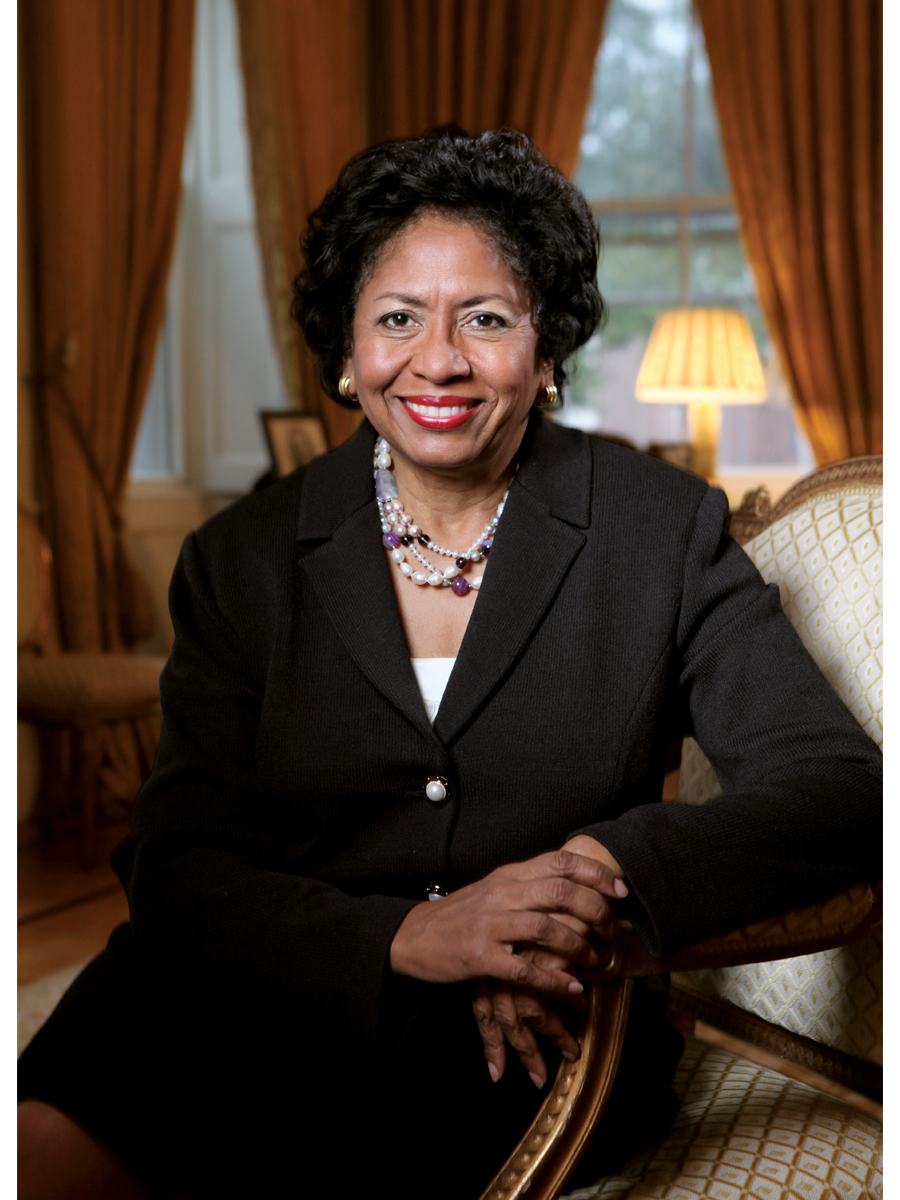
Ruth J. Simmons, former president, Brown University.
Many campuses currently involved in confrontations with troubled histories recognize Brown University as a pioneer in such matters. In 2001, Ruth Simmons, the daughter of a Texas sharecropper, became president of the university in Providence, Rhode Island, U.S.—as well as the first Black president of an Ivy League school. While leading Brown, Simmons used her platform to educate the public about little-discussed aspects of U.S. history and its colleges and universities.
Declaring in 2003 that educational institutions needed to confront their own histories, Simmons assembled a committee to explore Brown’s ties to slavery. The committee delivered the Slavery and Justice report in 2006, acknowledging how the university had benefited from the transatlantic slave trade and recommending a variety of ways for Brown to address this fact.
The university has acted on many of these recommendations, including making the report free and available, commissioning the campus Slavery Memorial identifying Brown’s role in the slave trade, and establishing the Center for the Study of Slavery and Justice in 2012. This work has continued under current president Christina H. Paxson, who made the Slavery and Justice report a part of undergraduate orientation and, in 2016, launched Pathways to Diversity and Inclusion: An Action Plan for Brown University, which has become a model for its comprehensive approach to accountability for fulfilling diversity and inclusion goals.
Marcus Martin, who recently retired as chief officer for diversity and equity at the University of Virginia, recommended in 2013 that a commission explore similar issues at the Charlottesville, U.S., institution founded by one of the nation’s first presidents, and slave owner, Thomas Jefferson. The UVA President’s Commission on Slavery and the University was charged with exploring the ties of campus sites to slavery and creating educational opportunities.
Among other initiatives, the panel recommended the construction of the Memorial to Enslaved Laborers, which opened in 2020. The pandemic delayed the public dedication of the memorial, but it is already becoming a focal point for gatherings and discussion. Situated within sight of the Jefferson-designed Rotunda, the memorial drew praise from New York Times art critic Holland Cotter: “It feels receptive and usable, a place for things to happen. … Power is not its language. Closure is not its goal. Active, additive remembrance is.” The memorial was also selected as the Best of Design Project of the Year by The Architect’s Newspaper.
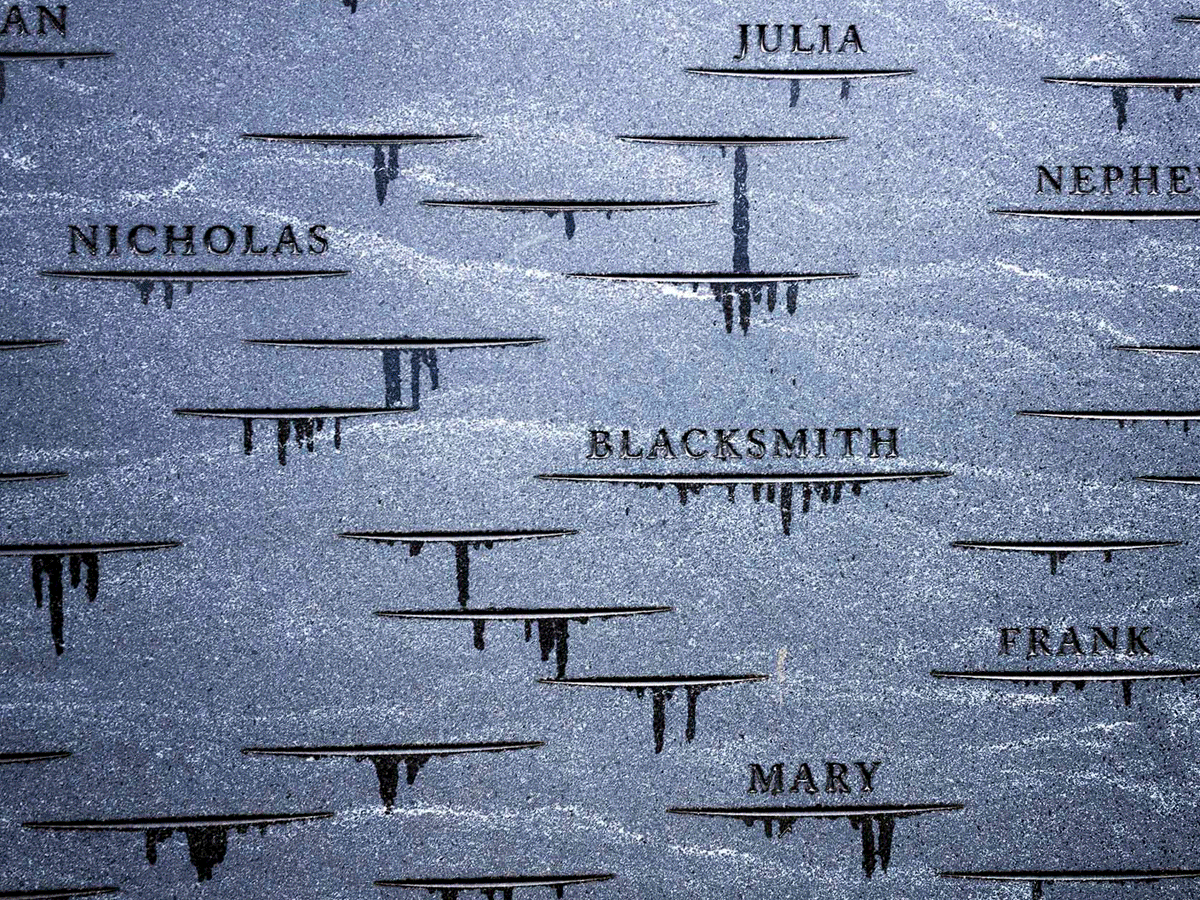
Last fall, the UVA Board of Visitors also endorsed several racial equity goals, including doubling the number of underrepresented faculty, developing a plan that leads to having a student population that better reflects the demographics of the Commonwealth of Virginia, encouraging affiliated organizations to develop scholarship programs for the descendants of enslaved laborers, and designing and launching educational programs around racial equity and anti-racism. The UVA board endorsed further contextualizing the university’s historic landscape and making additional name changes.
The existence of committees and commissions at Brown and UVA prompted other institutions to open similar conversations. In 2015, representatives from UVA and the College of William & Mary, Williamsburg, Virginia, U.S., formed a global consortium of universities confronting their own legacies: Universities Studying Slavery.
The group currently includes more than 70 institutions in the United States, U.K., Canada, and Ireland, all focused on “sharing best practices and guiding principles about truth-telling projects addressing human bondage and racism in institutional histories.” Brown and McGill universities signed on. Von Daacke heads the group, in addition to his role with the UVA President’s Commission on Slavery and the University, and says membership is growing by the month.
“Every time there’s a crisis, we get a bump,” he says. “The naming question came up pretty powerfully in the last year. Every school is wrestling with it in some way.”
‘Inconsistent with Our Values’
Indiana University Bloomington, U.S., is one such institution.
For years, students and alumni pressed IU’s leaders to address the fact that the biology building, a parking garage, and a river alongside campus bore the name of David Starr Jordan. The 19th-century zoology professor and former university president was an ardent supporter of eugenics. Jordan opposed mixing of races and the “dilution” of the white race. He believed in selective breeding.
“I’ve been on this campus for 21 years and it was something that would come up from time to time as a matter of debate,” says Chuck Carney, IU’s director of media relations.
The conflict reignited in 2020 after George Floyd’s murder. When concentric circles of protest spread around the world, the IU community energized around the idea that it was time for Jordan’s name to be stripped from prominent campus sites.
The university assembled a committee that studied the issue and presented a 60-page report in September 2020 recommending name changes. Shortly after, university President Michael McRobbie announced that Jordan’s name would be removed from three sites.
The changes were immediate. Jordan Hall is now the Biology Building. Jordan Avenue Parking Garage became the East Parking Garage. The Jordan River is now known as the Campus River.
McRobbie also promised to work with the city of Bloomington to rename Jordan Avenue, jointly owned by the municipality and the university.
“We cannot change the fact that [Jordan] was the seventh president of Indiana University and he put Indiana in the modern era of universities, but to honor him was inconsistent with what our values are and that was the message we put out,” Carney says. The university “also made clear that we [would] not honor someone who … stood for things we did not.”
The consensus was that students of color should not have to walk through a campus that hails people who would not want them there. Carney and others warn that campuses should accept that the process, while essential, might be messy.
A Welcoming Environment
Many voices go into carving out a resolution in how a campus is adorned, who is honored, and how elements are named—not only students and alumni, but also administrators, professors, and the surrounding community.
The McGill debate has illustrated how a statue or language can hold a great deal of symbolism. It’s not the first time the university and its community have engaged in such an examination. In 2017, Provost Manfredi commissioned the Working Group on Principles of Commemoration and Renaming, prompted in part by controversy over the Redmen moniker for McGill’s men’s varsity sports teams. As a result of the working group’s report—along with Indigenous and other community members’ longstanding objections—the teams officially became known as the Redbirds in 2020.
Manfredi says that the university’s “rigorous process” with the statue will be consistent with what was advised in the working group’s report, which suggested a frank depiction of James McGill. McGill has officially recognized that its own wealth originated in part from James McGill’s involvement in colonialism and the transatlantic slave trade. The university also appointed two provostial research scholars in institutional histories, slavery, and colonialism, who are investigating McGill’s ties to those subjects through their respective postdoctoral projects. The Action Plan to Address Anti-Black Racism is set to take a variety of stakeholder viewpoints and presentations into account before arriving at a decision on many fronts, including the statue.
The methodical pace may be frustrating for those aligned with De Oliveira, who sees the statue as a constant reminder that her university owes its founding to someone who would not have viewed her as an equal, or even human.
“He was an owner of five slaves. He did not treat his slaves well and he wasn’t a benevolent slave owner,” De Oliveira says. “The point is it’s important to think about how we glorify objects.”
Manfredi says that this is a component of McGill’s plans and actions, in addition to looking at myriad other opportunities to combat racism and foster inclusivity. While the statue debate has become a focal point and it’s an important discussion to have, Manfredi says he and the university are less fixated on removing names or objects than they are on enhancing the institution by spotlighting figures who have been overlooked in the past.
“We want to include names we have not celebrated as much as we could, whether they are women, Indigenous, Black, who made important contributions to the university,” he says, giving the example of Charles R. Drew, a Black surgeon who graduated from McGill’s medical school in the 1930s and developed blood banks in World War II (among other accomplishments). “It’s about telling the stories of people like Charles Drew in a more profound manner. It’s about broadening the scope. That needs to be changed.”
Whether the results involve removals, changes, or new honors, McGill’s action plan recognizes that the previous ways of honoring individuals left a deep impact on Black and Indigenous communities—groups that are steadily becoming a larger portion of the university’s constituents.
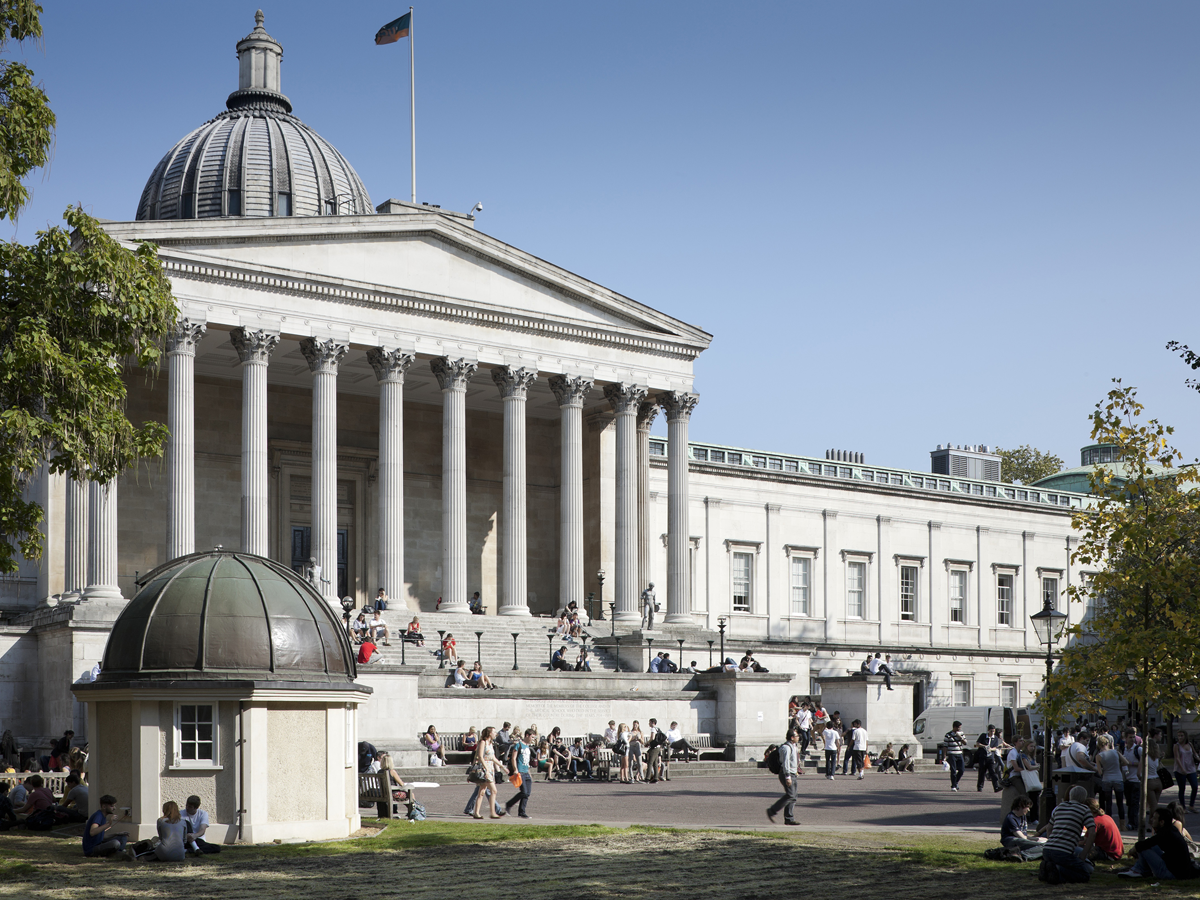
LECTURE THEATRE 115: The Galton Lecture Theatre is now known as Lecture Theatre 115. It was previously named after Francis Galton, who coined the term "eugenics" and endowed University College London with his personal collection and archive.
Denaming and Renaming
That negative impact isn’t limited to North America. University College London has been addressing its association with 19th- and 20th-century eugenicists Francis Galton and Karl Pearson. UCL buildings and lecture theaters were, until recently, named in honor of the scientists, who conceived and promoted a world view that discriminated against nonwhites and those with disabilities.
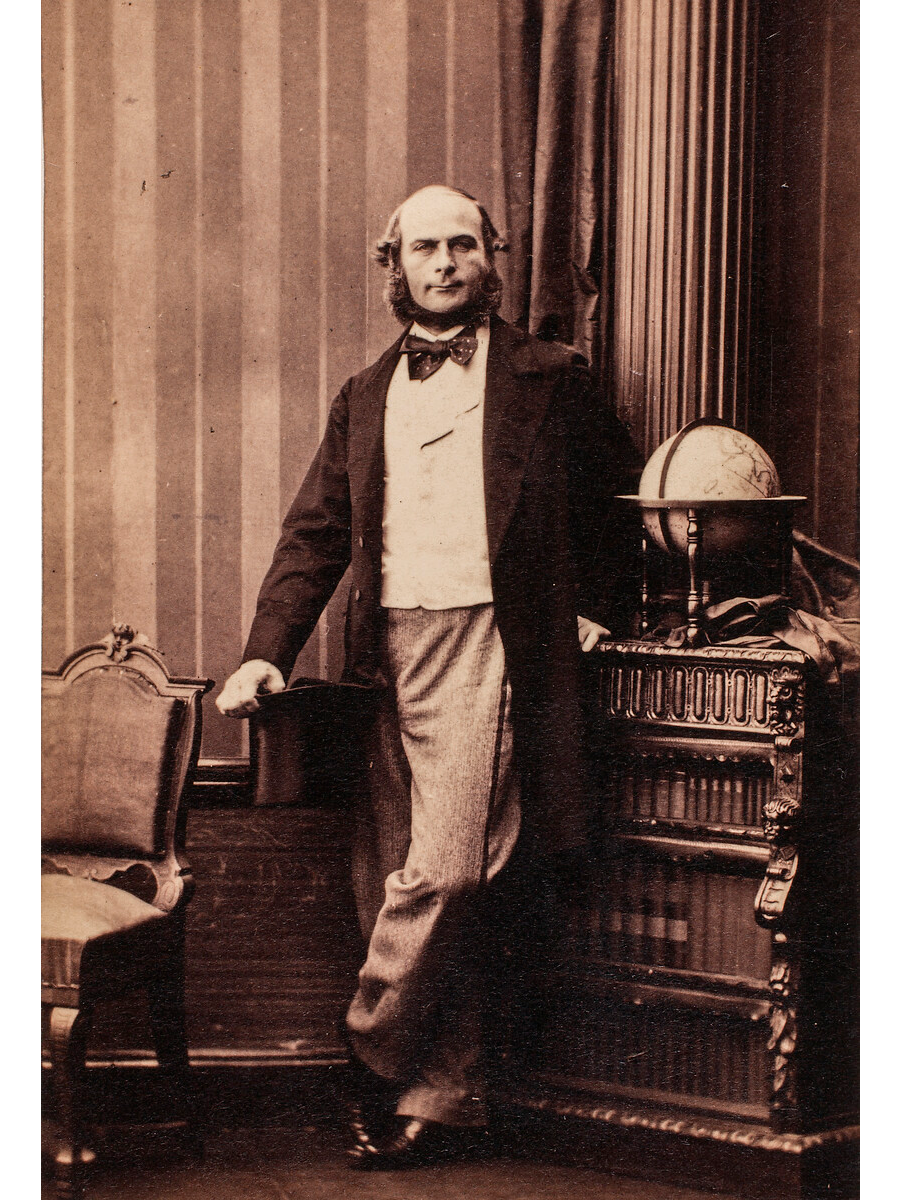
Francis Galton
“UCL considers its history of involvement in eugenics to be in direct contradiction to its founding values of equality, openness, and humanity,” the university acknowledged in an official apology issued in January 2021. “We apologise for being slow to interrogate properly the history and legacy of eugenics at UCL, and for failing to act with sufficient speed to remedy the ongoing effects on those in our community who are the targets of the eugenic mentality.”
The apology was one of many actions to come from UCL’s commissioning of an independent inquiry into the university’s history with eugenics in 2018. After two reports—one from the inquiry team and one from a subgroup—UCL denamed spaces glorifying Galton and Pearson in 2020. Adrian Punaks, UCL’s executive director of development, says that alumni were an important facet of the inquiry.
“As members of UCL’s community, the views and feedback of UCL alumni have been an essential part of UCL’s process to address its history and legacy of eugenics,” he says. “Our alumni were one of the key groups consulted as part of the independent inquiry and were invited to take part in the inquiry’s survey as part of a wide consultation with the UCL community and members of the wider public.”
Denaming buildings and releasing an official apology garnered the most media attention, but UCL’s response group has announced more plans that will take longer to be fully realized. These include improving access for students and staff with disabilities, closing the scholarship gap between white and minority students, and addressing eugenics head-on with new learning activities. One such project is the Living with Eugenics podcast, which scrutinizes UCL’s part in eugenics and discusses the best ways to deal with that history.
While denaming spaces was an important step in 2020, UCL also renamed a key element of the university: the Sarah Parker Remond Centre for the Study of Racism and Racialisation. Punaks says that the center—named for the abolitionist and women’s rights activist—wouldn’t be possible without the support of UCL donors and alumni. Punaks says that philanthropy will continue to play a major role in assisting students and the university in moving forward.
“Philanthropy is already well-established as an enabler of equality, diversity, and inclusion at UCL,” he says.
A Continuing Education
In its work, Universities Studying Slavery has learned a few best practices, according to von Daacke, such as these: barrel past the notion that such debates will be bad for the brand, expect some opposition, and understand that a lot of the disapproval comes from a place not in tune with what’s currently going on at the institution.
That last point might be a difficult one for many in advancement, who work so closely with donors and alumni. But von Daacke, Indiana University's Carney, and Oregon State’s Clark agree that it is most important to concentrate on the path forward, understanding that the perspectives of alumni and donors might not instantly align with that plan.
When under pressure, leaders at IU learned that it is important to stay focused on the goal of making current and future constituents feel welcome on campus. Carney disagrees with critics who say that removing names, statues, or monuments amounts to erasing university history. He believes that the reckonings are calling for actions that should have happened long ago.
“It’s not just that they’re not proper with a modern lens, [it's that] they should never have been,” Carney says.
The removal of Jordan’s name from campus sites is not the only result of 2020’s campus upheavals. In June, IU renamed an athletic field house after alumnus Bill Garrett, who played basketball for the university in the 1940s and 1950s, becoming the first Black athlete to regularly play in the Big Ten Conference.
The university also created a Pandemic Health Disparities Fund to help students impacted by the coronavirus, won a grant to help medical school students better serve marginalized communities, and created a Racial Justice Research Fund to support studies involving racial equity.
Carney says that in order to stay focused in the reviews that led to such action, university leadership agreed that it is important to measure whether the people and concepts hailed by statues, monuments, and building names mesh with the overall mission of the college or university.
“Are we making people feel unwelcome?” asks Carney, who says that Jordan’s history should be discussed, but not honored. “That’s not what we’re here for.”
McGill’s Manfredi emphasizes the sustained effort and dialogue that are required. It’s not about doing anything one time: listening to one story, making one plan, taking one action.
“The Action Plan [to Address Anti-Black Racism] is not a document engraved in stone. It’s a dynamic, living plan,” Manfredi says. “We want to continually engage with constructive dialogue. Everyone will benefit.”
UVA’s von Daacke recommends that institutions must also keep in mind that the process will not be easy or quick, and they should make sure that any committee that is established does not trickle off into oblivion, but stays on target.
“If we have created a space where schools can openly discuss these issues,” he says, “we’ll have added to the conversation in some powerful way.”
In the early years of UVA’s self-exploration, this came through loud and clear.
“Some people think that if you talk about unpleasant truths, it will be bad for the university and bad for the brand,” von Daacke says. “If we are scared of investigating our own past, we’ve kind of failed as educational institutions.”
About the author(s)
Melanie Eversley has written for USA Today, the Atlanta-Journal Constitution, Diverse Issues in Higher Education, and more.
Bryan Wawzenek is the Communications Manager at Harper College in Palatine, Illinois, U.S. He is a former CASE Content Creator.
Tags
Article appears in:
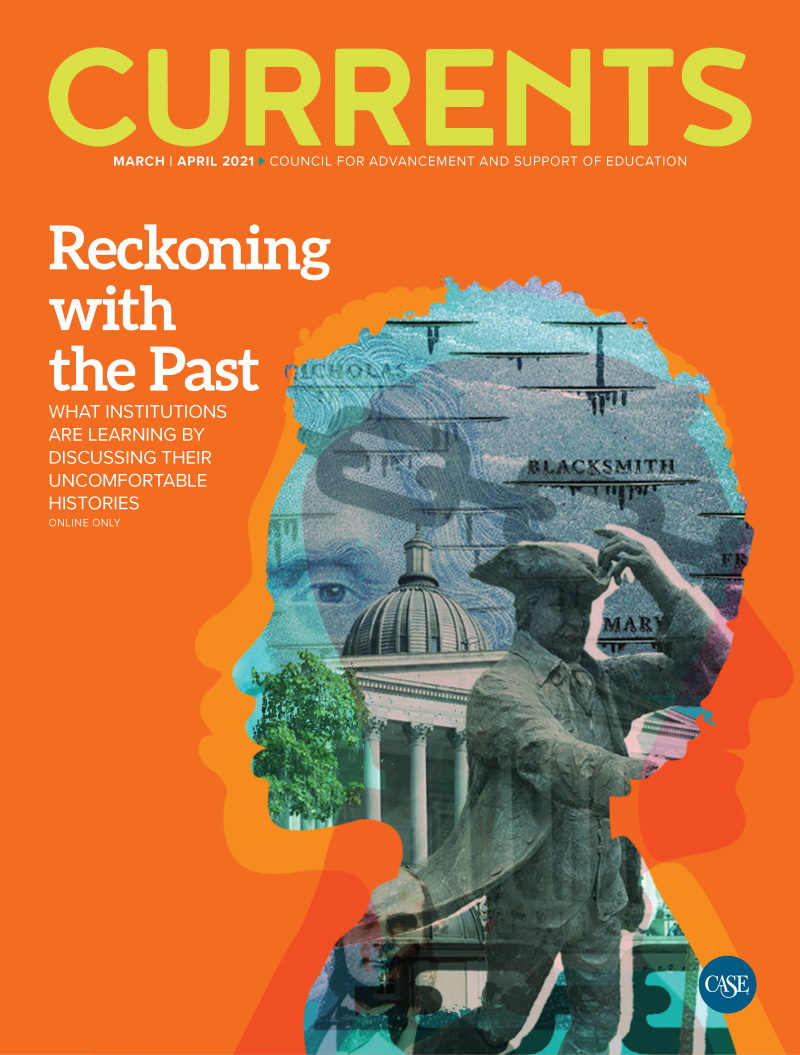
March - April 2021
DIGITAL ONLY ISSUE
Reckoning with the Past: How university leaders, alumni, and students are discussing their institutions’ uncomfortable histories and fostering a welcoming environment moving forward. Plus, demystifying data in advancement, writing a case for support, and an excerpt from a popular new CASE book—Diversity, Equity, and Inclusion in Advancement.
